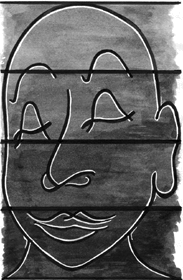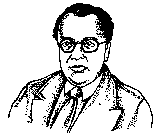

The upper- caste intelligentsia has always been hostile to the ideal of emancipation
Contemporary Indian scholarship considers the Bhakti movement a landmark and the beginning of the Indian renaissance. Whether Indian society has as yet witnessed a renaissance phase in the classical sense of the term is an altogether different question. However, it is now commonly agreed that the Bhakti movement (1400-1700) was a pan-Indian phenomenon and was manifest in its most radical form in the Hindu heartland of the country. The genesis of Bhakti is traced to the Vaishnavite Alawar saints of the far south. Of the known nine Alawars, many belonged to the untouchable and Shudra castes. From the school of Alawars came Acharya Ramanuja, a disciple of a Shudra guru, Kanchipurn of Kanchipurn.
Acharya Ramanuja confronted Shankaracharya�s thesis of the �Brahma Satyam Jagat Mithya�. At the dawn of the medieval era, the Shankaracharya (early 9th century), is credited with reviving the Varnashram Dharma which had earlier been severely dented through Buddhist intervention. Acharya Ramanuja, while challenging Shankaracharya�s thesis, had argued that the �world is real� and, therefore, Brahma cannot be separated from the real world. Since it is the Shudra saints, predominantly, who evolved the Alawar tradition, all they were fighting for was the creation of space for everyone within the Varnashram Dharma. This was a positive intervention, in the sense that it challenged the Brahmins if not Brahminical hold over the spiritual life of people.
| It has been quite authoritatively argued that Ramanand, born in a Brahmin family at Prayag, brought the Bhakti movement (in the 14th Century) from Ramanuja�s Sri Sampradai to the north. Ramanand, historical evidence suggests, was highly liberal in attitude and democratic by temperament. He insisted that karma or bhakti determines a person�s status, not his varna or caste identity. Among the twelve disciples of Ramanand, many belonged to the untouchable and lower castes. Two of them, Sant Ravidas, a chamar (leather worker), and Sant Kabir Das, a kori (weaver), both untouchables by origin, re-oriented the Bhakti movement along radical lines. |
 |
The entire Bhakti movement evolved along two broad lines, namely, the Nirgun and the Sagun branches. These branches further split into sub-branches. It is necessary to investigate why the movement evolved into branches and sub-branches. The Nirgunis dis-missed the age-old concept of Avatar (re-incarnation), so fundamental to Varnashram Dharma philosophy. The Gyan Margis also launched an all-round attack against varna/caste division of Indian society. While the Gyan Marg stream was led by Sant Ravi-das and Sant Kabir Das, both untouchables, the Prem Marg stream was led by the Sufi sants, most of whom belonged to the Muslim lower castes.
The Sagun branch not only revived the concept of re-birth and re-incarnation but also reinforced the necessity of the varna/caste division of society. Sants of this branch theorised that the breaking up of the varna/caste institutions would cause the collapse of the society. Not surprising, since the Sagun branch was led by Tulsidas, a Brahmin by origin. The only exception was Mirabai who belonged to the Krishna stream of the Sagunis and who rejected caste-morality. She accepted Sant Ravidas as her guru. Subsequently, two serious attempts were made on her life.
Gajanan Madhav Muktibodh has examined various aspects of the Bhakti tradition. According to him: the Bhakti movement began as a revolt of the lower castes/lower classes against the upper castes/upper classes; it drew people from all castes/classes but the egalitarian agenda was generally raised by the lower caste sants; and, when the movement was taken over by the upper castes, the entire movement disintegrated. The �Indian renai-ssance�, as K. Damodaran describes it, and the �revolutionary social movement�, as Dr. Shiv Kumar Mishra opines, was ultimately destroyed by the non-organic intelligentsia of that time.
The 20th century has witnessed epoch-making changes through out the world, not only in the areas of science and technology, but in every aspect of human life. Politically, the liberation struggles put an end to direct colonial rule. Two great revolutions � the Bolshevik Revolution and the Chinese Revolution � took place. In the case of China, under the leadership of the Chinese Communist Party, the liberation struggle was launched on two fronts simultaneously � to attain independence from colonial powers and to bring about a revolutionary transformation of the Chinese socio-political system. The Chinese Communist Party succeeded in both.
In the Indian context, while independence from British rule was fast emerging as the central agenda of the Indian middle class, Dr. Amb-edkar made a serious attempt to usher in the agenda of a revolutionary transformation of Indian society. Dr. Ambedkar was not only dismissed but also mocked by the non-organic intelligentsia for �subverting� the �great freedom struggle�.
What was Ambedkar demanding? And why was the intelligentsia of all hues hostile to his views? A survey of Ambedkar�s writing reveals that all that he was arguing for was: a revolutionary transformation of land-labour relationship along the lines of �land to the tiller�; putting industrial assets in the hands of the state; free, quality education to all�; representation of Dalits and other deprived sections in government services and legislative bodies in order to democratise the organs of the Indian state; and, a totally humanist and egalitarian goal for the Indian state.
In today�s context, what is the response of the nation�s intelligentsia towards the BSP and its leader Kanshi Ram? There is no major newspaper or TV channel backing the BSP. There is not a single prominent non-organic intellectual who supports the BSP. In fact, the intelligentsia of all hues has mocked the BSP since the party�s inception in 1984. Most intellectuals have displayed an amazingly high degree of hostility towards Kanshi Ram and his party. All that the BSP has been talking of since its foundation is Samajik Parivartan (social transformation)! While the party is fast emerging as the major political platform of the Dalits, all major political blocs in the country have made successful attempts to isolate it.
The wealth of historical information available shows the attitude of the non-organic intelligentsia since the Bhakti period. It shows that, one, the non-organic intelligentsia joins the emancipatory movement at its peak only to dilute the radical content of the movement; two, when the movement becomes weak, while morally upholding the pro-people line, they launch an assault on the organisation and the leaders of the movement; and, when the movement collapses, they begin re-discovering the beauty of its �great historical relevance� and the �greatness of its leader�.
This is true of the Bhakti move-ment. Sant Ravidas, Sant Kabir Das and Mirabai were mocked in their lifetime but are eulogised today. Ambedkar, too, was mocked in his life-time, but is idealised today. The non- organic intelligentsia is waiting, like vultures, for the BSP to achieve its peak (when they may join it) and, also expecting its demise, are waiting finally to write obit-uaries as to how the BSP was a great social necessity and how great Mr. Kanshi Ram was.
History demonstrates that this is nothing but a continuation of a tradition where the non-organic intelligentsia is wary of giving up the privileges which have come to it through the irrational varna/caste social structures. It is also assailed by a deep-rooted self-doubt about its own ability to create a new social order.This is the fundamental reason why Indian society has not witnessed a successful revolution in its known history.
Chandra Bhan Prasad
(Chandra Bhan Prasad is president, Dalit Shiksha Andolan)

![]()
The agenda, which Ambedkar was proposing has been the ideal of most emancipatory struggles all over the world ! Yet, the nation�s intelligentsia responded to his call with acute hostility.
The agenda, which Ambedkar was proposing has been the ideal of most emancipatory struggles all over the world ! Yet, the nation�s intelligentsia responded to Ambedkar�s call with acute hostility.